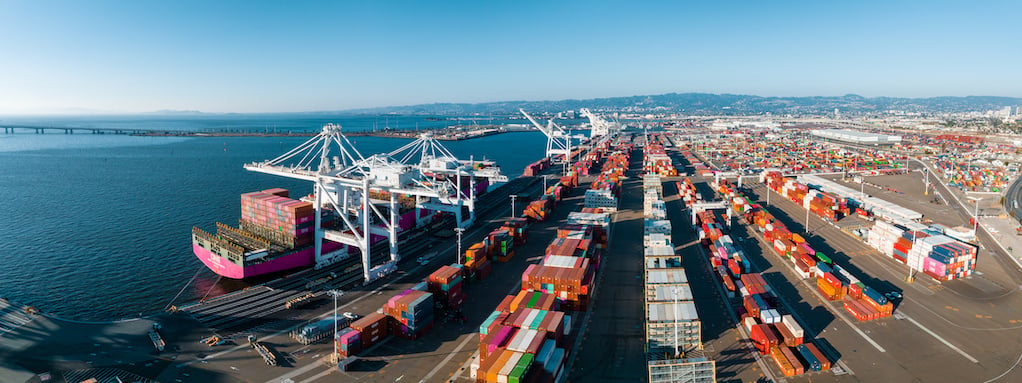The temporary suspension of the dock workers’ strike by the International Longshoremen's Association (ILA) might give shipping companies and businesses along the East and Gulf Coast ports some breathing room, but the risk of a full-scale work stoppage in January remains real.
Should the ILA and the United States Maritime Alliance fail to reach a lasting agreement, the supply chain disruptions caused by a renewed port strike could wreak havoc across industries, with commercial real estate (CRE) bearing significant consequences.
While the tentative deal offers a temporary reprieve, unresolved issues like automation and job security could send striking workers back to the picket lines, shaking up CRE markets across the U.S. Read on, in this article, you'll learn:
-
Supply Chain Impact: A renewed dock workers’ strike in January could disrupt East and Gulf Coast ports, causing severe delays and economic losses of up to $4.5 billion per day.
-
CRE Market Disruption: Industrial and warehouse properties, especially near ports, would face bottlenecks or slowdowns, while office space demand tied to international trade may dip.
-
Onshoring Surge: The fragility of global supply chains could drive businesses to accelerate onshoring, increasing demand for domestic warehouses and long-term leases.
A dock workers’ strike directly hits one of the most critical arteries of global commerce: ports.
If dockworkers at ports across the East Coast and Gulf Coast resume striking in January, the effect on supply chains will be immediate and far-reaching. Delays at these coast ports will disrupt the movement of shipping containers, causing inventory severe shortages, which would ripple through the entire economy.
|
"A strike at the East Coast and Gulf Coast ports could cost the U.S. economy between $3.8 billion and $4.5 billion per day in economic losses." -Investopedia |
CRE spaces tied to logistics and warehousing would be among the first to feel the pinch. These entry points handle the bulk of international trade, and any bottleneck in the system can choke off supply lines.
For industrial CRE, particularly those near affected ports like New York and New Orleans, warehouse spaces could either become overwhelmed with unsold inventory or face emptiness as containerized exports grind to a halt.
CRE landlords reliant on short-term leases for their tenants could experience a slowdown in activity, as tenants might delay renewing agreements or signing new leases until the labor unrest is resolved. On the other end, this strain may push many companies to seek short-term storage solutions. Landlords may find themselves caught between taking advantage of the sudden demand or bracing for potential vacancies if the strike drags on.

Rail crossings and inland distribution centers dependent on Eastern ports will also face a ripple effect from the disruption. Business groups fear that a prolonged strike will further strain the supply chain management systems, leading to higher prices for consumers and increased costs for warehousing and transportation.
How a Strike Could Push Onshoring Initiatives
If the January strike materializes, it could become a key inflection point for businesses to accelerate onshoring initiatives. The fragility of supply chains, already exposed during the pandemic, will once again be in the spotlight. Companies might decide that the benefits of keeping production and distribution closer to home outweigh the costs of relying on international shipments vulnerable to labor disputes and global disruptions.
Demand for domestic manufacturing and warehouse spaces would surge as businesses look to reposition their supply chains within the U.S.
Long-term leases on high-quality, well-located warehouses could become essential for companies seeking to insulate themselves from future international shipping risks. Investors and developers with an eye on the industrial market could see this as a moment to expand portfolios, betting on a permanent shift toward onshoring.
For CRE, this means that demand for industrial properties away from major ports will likely grow. Onshoring initiatives could see an increase in long-term leases for domestic warehouses, as companies try to shield themselves from future disruptions at ports affected by dock workers' disputes. Industrial hubs in inland areas could benefit, with many transportation analysts suggesting that companies may secure additional spaces to create redundancy in their supply chains.
Maritime Alliance Negotiations: A January Showdown?
The collective bargaining process between the ILA and the United States Maritime Alliance is at the center of this potential crisis. The maritime alliance, representing the shipping companies, has been in tense negotiations with the union over key issues like automation, job protection, and wages.
If a strike resumes in January, it will underscore the union’s fight for job security in the face of technological changes.

This comes at a time when the warehouse industry is being flooded with innovation, linked heavily to automation and artificial intelligence. The "robotification" of the industry means that tasks like picking, packing, and sorting, which once required human labor, are being phased out by technological streamlining.
While this advancement increases efficiency, it also threatens jobs—exactly the kind of automation that union workers are rallying against. As warehouses become more robotified, the need for human labor could diminish, exacerbating tensions around job security in industries dependent on manual work.
CRE Uncertainty Amid Labor Unrest
For commercial real estate markets, the uncertainty created by labor unrest can have significant consequences. Industrial real estate will be the hardest hit, but other sectors like retail and office spaces will also feel the pressure. Retailers, particularly those reliant on imported goods passing through East Coast ports, could notice shortages in the aftermath of a January strike. The holiday season may dodge this bullet, but a prolonged strike into the new year would impact product availability and consumer spending.

Additionally, the potential for a dock worker strike or further supply chain disruptions could hit construction and renovation projects hard. The growing trend of converting office buildings into residential or mixed-use spaces could slow down or become more expensive as supplies for these projects face bottlenecks.
Materials like steel, glass, and specialized equipment, crucial for these conversions, may be delayed or more costly to procure, creating a significant hurdle for property owners looking to repurpose vacant office space.
But it's not limited to just office space. Any construction will be slowed down due to limited access to supplies. This means residential, commercial, retail, etc. construction will grind to a halt and/or will become much more expensive as the cost of the materials jump with demand.
This will exacerbate financial pressures on developers and landlords already struggling with the post-pandemic office market downturn.
Long-Term Impact on CRE
The possibility of another dock worker strike in January is more than just a short-term disruption. If labor disputes continue, they could lead to lasting changes in how businesses manage their supply chains, directly influencing the demand for CRE.
Onshoring initiatives will gain even more traction, shifting demand away from port-centric real estate to inland hubs and domestic manufacturing spaces. The industrial real estate sector may experience increased demand in inland regions as companies create redundancy in their supply chains.
|
"The ports staffed by ILA members, including those in New York, New Jersey, and Savannah, Georgia, receive 41% of the United States’ port volume." -PYMNTS |
Should a strike last longer than expected, wages, job security, and automation concerns will remain at the forefront of negotiations.
Now that the issue of wages have been settled, the other two issues remain. The impact of automation on job security will be at the forefront for union workers, potentially extending the strike, further complicating supply chains. CRE markets will need to brace for these changes, especially as investors and developers look to shift their portfolios toward more stable and flexible spaces that can withstand future supply chain shocks.
Tenants Prepare for January’s Uncertainty
The current suspension of the dock worker strike offers only temporary relief to businesses and commercial real estate markets. With negotiations between the ILA and the United States Maritime Alliance still ongoing, the possibility of a January port strike looms large. For CRE investors, landlords, and tenants, the time to prepare for these potential disruptions is now.
By diversifying supply chains, considering onshoring initiatives, and securing flexible leasing agreements, companies can better insulate themselves from future instability.
As union support remains strong and unresolved issues continue to fester at the bargaining table, the stakes for both the ILA and the Maritime Alliance are high. If a deal isn’t reached by January, CRE markets could face another wave of disruption, particularly in industrial spaces reliant on the ports of the East and Gulf Coasts.
Now more than ever, warehouse tenants need to be proactive in securing the right space that can withstand supply chain disruptions. Don’t wait until the next strike or shipping delay catches you off guard. Whether you’re looking to diversify your operations or strengthen your supply chain, finding the best warehouse is key to maintaining stability.
Download our comprehensive guide, "Finding Your Best Warehouse," and learn how to navigate the complexities of the current market, evaluate onshoring options, and secure flexible leases that safeguard your business. Stay ahead of the curve and protect your operations from future disruptions.








